Fish Farming and First Nations
Air Date: Week of February 13, 2009
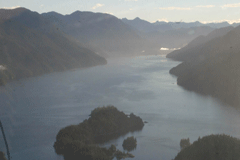
The Broughton Archipelago lies roughly 250 miles north of Vancouver. (Photo: Alexandra Morton)
British Columbia has the fourth largest aquaculture industry in the world. But some First Nations people in the region say the farms are killing off the wild salmon that form the foundation of a two billion dollar tourism and commercial fishing industry – and they’re taking their complaints to court. Host Bruce Gellerman speaks with Chief Bob Chamberlin, who is representing over 4,000 native peoples in a class action lawsuit, and Alexandra Morton, a scientist who has been studying the salmon stocks in the region for years.
Transcript
GELLERMAN: More than 40 percent of the world’s seafood is farm-raised and one of the largest centers for farming salmon is British Columbia, Canada. In the Broughton Archipelago alone, along Vancouver Island there are 29 fish farms.
But a lawsuit, just filed by First Nation tribes, claims that farmed salmon raised in open nets at sea are threatening wild salmon, and aquaculture is undermining a billion dollar economic food chain and a way of life. Chief Bob Chamberlin speaks on behalf of the First Nations in the lawsuit.
CHAMBERLIN: Well when you come into the territory of our people, it was once incredibly bountiful with every type of marine species you could imagine. And right now there’s a serious and sharp decline in pink salmon stocks, chum stocks, the various species of clam, herring, bouligan. There’s not one species that’s doing well. The only thing new in our territory is the fish farms.
GELLERMAN: So how are farm-raised fish hurting the wild fish?
CHAMBERLIN: Well, the farm-raised fish or the open net caged farm fish systems - are just ideal to capture the sea lice from the wild salmon that come back to spawn and it allows for a perfect environment for them to proliferate throughout the year.
GELLERMAN: Sea lice?
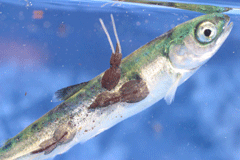
Young pink salmon smolt infected with sea lice. The open net pens are fertile habitat for sea lice, as well as farmed salmon. (Photo: Alexandra Morton)
CHAMBERLIN: Sea lice, that’s correct.
GELLERMAN: What do the sea lice do to your fish?
CHAMBERLIN: Well, the small salmon smolts that leave the river do not have their scales developed, so they’re not able to fend off a parasite such as this. So it takes very little in terms of numbers of sea lice to kill the smolts when they leave the river.
GELLERMAN: So you’re saying the fish farms and the sea lice are what’s causing the collapse of these wild fisheries.

Broughton inlet. (Photo: Alexandra Morton)
CHAMBERLIN: Well I think it’s more than just the sea lice, and that’s the thing that I want people to understand is when we talk about the impacts on wild salmon, that is one impact from this industry. Though it’s a very significant impact, there are other impacts in the region which are not being accounted for or researched and documented.
GELLERMAN: Well Chief Bob Chamberlain, hang on, because I want to bring into the conversation now Alexandra Morton. Ms. Morton,
MORTON: Hi
GELLERMAN: You’re a marine biologist who’s lived up there for what – decades I guess, right?
MORTON: Yes, since 1984.
GELLERMAN: And you’ve studied the effects of farm raised salmon on the wild fish.
MORTON: Yes, originally I was studying the killer whales in the area, but – and I thought the fish farms were a good idea, but as they moved in and got bigger, the impacts just grew. And that was the problem, because initially the farms only had a 125,000 fish per farm. And then they grew to the point where – at points we had 1.3 million fish per farm. Now what happens with the farm is when a fish becomes sick, it spreads to the other fish, and it brews the disease, whatever it is, to the point where the pathogens are pouring out at a level that the wild fish just can’t bear. It’s the difference between standing a football field away from a guy with the flu to being stuck in an elevator with six guys with the flu, you know. Under one condition you won’t get it and the other, you probably will. And that’s where the balance gets upset.
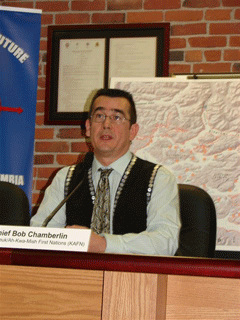
Chief Bob Chamberlin.
GELLERMAN: You know I just noticed before I gave you a call that the premier of B.C., Gordon Campbell, came out with a new report that was four years in the making. It’s from the B.C. Pacific Salmon Forum and they say that wild and farm fish can coexist.
CHAMBERLIN: There would have to be some pretty stringent criteria set around the operation of these farms for us to agree to that.
GELLERMAN: What would you like to see?
CHAMBERLIN: I would like to see the fish farms not located on migratory routes of wild salmon smolt.
GELLERMAN: That way they wouldn’t pick up these lice.
CHAMBERLIN: That’s correct. I think we all can agree that nature is perfect in everyway, so when wild salmon would come to the river to spawn, they would indeed have sea lice on them. But when they would die after they had reproduced in the rivers, the sea lice would eventually die in the region as well.
GELLERMAN: Ms. Morton, they use open nets right now. And they put them into these waterways. Why don’t they just enclose them?
MORTON: Oh. Because they’re the only farmers in the world that don’t shovel their manure. And they’re putting in tons of food. And one of my studies right now is on the mountains of sediment that are sitting on the sea floor in Chamberlin’s territory. They don’t want to deal with that stuff. No one does. So right now they are getting a free flush.
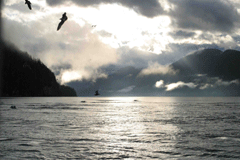
A deep sea bluff in British Columbia. (Photo: Alexandra Morton)
GELLERMAN: Well what are the conditions of the wild salmon right now? How many more runs of wild salmon can make it around these fish farms in the archipelago and out to the ocean with the present conditions?
MORTON: None of them. They’re all doing very poorly. The littlest salmon we have, the pink and the chum, they are dying outright. And then the larger ones, the spring salmon, Chinook or king as they’re called, and the Coho, they eat these infected little pink and chum fry and then the lice get on them. And the wild salmon are like a power cord to British Columbia. They go out to the ocean and they pick up all the energy out there from the sun hitting the water, creating plankton blooms and all that goes on there. And they package it into a delicious package and then they come back to us on a schedule. This is incredibly valuable. This is why the Broughton Archipelago supported over 10,000 First Nations people. They are funding a huge wilderness tourism industry. They are feeding the trees that are pulling the carbon out of the atmosphere. They’re one of those animals designed to feed the masses and make systems work. And so if you cut them, the whole province is gonna dim.
GELLERMAN: Chief Chamberlin, sounds like really what you’re saying is that, no, the fish farms can’t co-exist with the wild fish.
CHAMBERLIN: What I’m saying is it’s the obligation and the right of every First Nation to have meaningful input into the activities that go on within their traditional territory. And there are First Nations on this coast that are very supportive of aquaculture industry. But I want them to be able to have the opportunity to make that decision for an activity in their territory. But by saying that, I also want our First Nation’s view on this and the decision to not have it in our territory also respected.
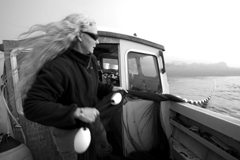
Alexandra Morton hauls in a net. (Photo: Nik West)
GELLERMAN: Well it seems the implications of what happens on the Broughton Archipelago could be vast, because farm fishing is enormous, and it’s going to only get bigger. And this could have an effect upon fish farms worldwide.
MORTON: Yeah, well there’s all kinds of fish farming. The problem with salmon farming from just a completely objective point of view is they’re farming carnivores. So there are fishing stocks and then they’re feeding those fish to the farm salmon. And then they’re taking out less fish. So it’d be like farming wolves by feeding them chickens. But farming a fish that eats vegetable matter and then you take the waste of the fish to grow your vegetable crops, well now you’re into a closed system that can prosper. Farming salmon – I don’t think it’s gonna last. They’re running out of wild fish, they have huge disease problems worldwide. Their shareholders are taking a beating. And as soon as the U.S. decides they can’t afford the product, they’re out of here, and we’re left with their mountains of waste on the sea floor.
GELLERMAN: Chief Chamberlin, what happens to the First Nations on the Archipelago if the salmon don’t come back, the wild salmon are gone?
CHAMBERLIN: That is – would be such a catastrophe. You have to appreciate that wild salmon are an integral piece to our way of life and our culture. I’ll use the most recent example. Last weekend I was at a naming feast for a small child, and when I attended that feast I knew exactly what I would be eating and it would be all the seafood that’s from our territories. Within our culture we have various dances and, you know, there’s a salmon dance. It’s something that our twins of our families dance. You know how special twins are to any given family of any culture, and those are the ones that do the salmon dance for our territories or for our people.
GELLERMAN: Well Chief Chamberlin and Ms. Morton, thank you very much. Really appreciate it.
CHAMBERLIN: Thank you – appreciate your interest.
MORTON: Thank you so much.
GELLERMAN: Biologist Alexandra Morton and Chief Bob Chamberlin spoke to us from the Broughton Archipelago.
And we have this response from one of the largest fish farming companies in the region, Marine Harvest, quote: “the industry is committed to stringent standards and sustainability on the British Columbia coast."
Links
Living on Earth wants to hear from you!
Living on Earth
62 Calef Highway, Suite 212
Lee, NH 03861
Telephone: 617-287-4121
E-mail: comments@loe.org
Newsletter [Click here]
Donate to Living on Earth!
Living on Earth is an independent media program and relies entirely on contributions from listeners and institutions supporting public service. Please donate now to preserve an independent environmental voice.
NewsletterLiving on Earth offers a weekly delivery of the show's rundown to your mailbox. Sign up for our newsletter today!
 Sailors For The Sea: Be the change you want to sea.
Sailors For The Sea: Be the change you want to sea.
 The Grantham Foundation for the Protection of the Environment: Committed to protecting and improving the health of the global environment.
The Grantham Foundation for the Protection of the Environment: Committed to protecting and improving the health of the global environment.
 Contribute to Living on Earth and receive, as our gift to you, an archival print of one of Mark Seth Lender's extraordinary wildlife photographs. Follow the link to see Mark's current collection of photographs.
Contribute to Living on Earth and receive, as our gift to you, an archival print of one of Mark Seth Lender's extraordinary wildlife photographs. Follow the link to see Mark's current collection of photographs.
 Buy a signed copy of Mark Seth Lender's book Smeagull the Seagull & support Living on Earth
Buy a signed copy of Mark Seth Lender's book Smeagull the Seagull & support Living on Earth

